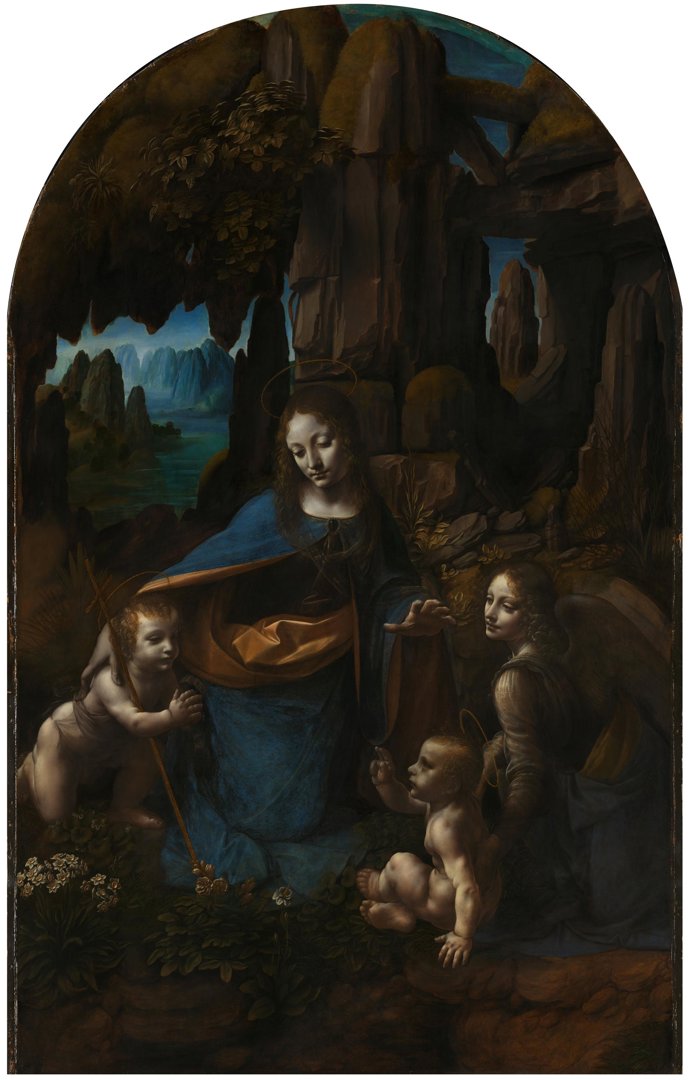Leonardo da Vinci's 'The Virgin of the Rocks'
Audio description
This is a description of 'The Virgin with the Infant St John the Baptist adoring the Christ Child' or as it is more commonly called 'The Virgin of the Rocks' by Leonardo da Vinci. It is an oil painting on poplar, nearly 190 cm high and 120cm wide, painted between 1491 and 1508.
The painting was commissioned as part of a large altarpiece in a Franciscan convent in Milan. This painting would have been in the centre, glowing and jewel-like.
Today, in the gallery setting, it is on a plinth so that we experience the painting just as when it was part of an altarpiece. It has a cornice on top of two side pilasters, decorated with carved organic forms, gilded in bright blue and gold.
The three figures, together with an angel, are set against a rocky landscape, a distant lake and beyond that, blue hills. A shaft of light from the top left-hand corner moulds the figures, so they glow. All but the Angel have the thinnest of gold rings as halos, shown as ellipses above each head.
Mary is the highest figure. She kneels in the centre, her arm around the shoulders of the chubby toddler who kneels beside her on the left: John the Baptist, her head turned to gaze down at him. She holds out her other arm, palm down, in a protective gesture above the infant Christ on the right.
He sits with legs crossed in front him, in profile. His right hand is held up in a blessing motion towards John the Baptist. His left arm, closest to us, is down by his side balancing him. He looks as if he is sitting on the edge of a rocky ledge that falls away in the foreground, at the very bottom of the composition. It is edged with vegetation, some flowers that look like a mix between primroses and daffodils, sprouting between the rocks to the left.
There is no danger however, because an angel kneels behind Christ, to the right, putting a steadying hand in the small of his back. The angel is facing into the group, their downcast eyes adding to the serenity.
A rocky cave structure encloses the figures, in warm earthy brown hues, the colours becoming the cooler blues, aquamarines, and hazy greys of the distant landscape beyond the cave. Rather than using linear (or mathematical) perspective, Leonardo is exploring a more subtle ways of depicting distance through colour, focus, light and dark, known as chiaroscuro.
Everything on the flat surface of a painting could be made to appear three dimensional, casting shadows with multiple densities, emerging from the gloom to shimmer and radiate light. He said “The artist who avoids shadows, avoids the glory of art”.
In the low light of the cave, the ultramarine blue of the Virgin’s dress and cloak appear a deep, rich colour; the flashes of gold lining an orange ochre.
Leonardo has manipulated the paint, his brushstrokes indiscernible as he has blurred and softened the edges of the forms at the point where they curve round into shade. This effect is called sfumato, from the Italian verb ‘to turn to smoke’. It creates a sense of ambiguity and suggestion, rather that painting everything in fine, hard detail. It gives his figures the appearance of breathing and shifting in a believable space.
The painting is concerned with a controversial idea which emerged in the 12th century, championed by the Franciscans. They reasoned that for Christ to be born without original sin (passed down from Adam and Eve for disobeying God), Mary had to be free of sin also. This meant that she would have been conceived by God before creation itself.
This idea of an event taking place before the dawn of time is a hard concept to show visually, and it could be the reason that Leonardo sets the figures in a primitive, almost hostile landscape. Over five hundred years on, even today in the busy gallery, it still exudes a quiet power, drawing the viewer in to experience something inexplicable and very special.


